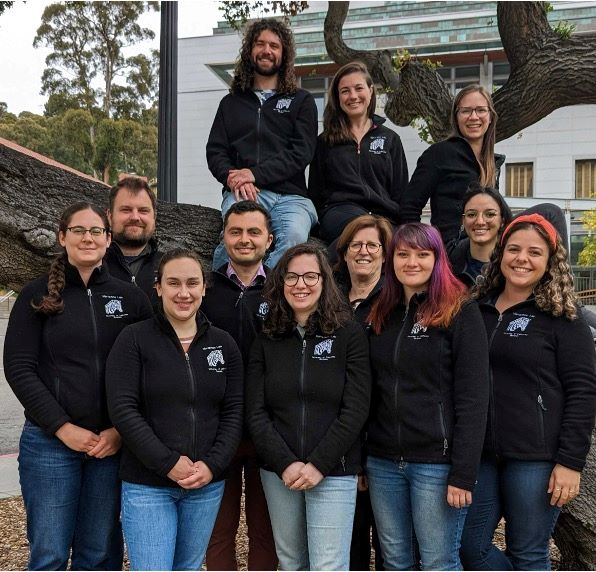
Susan Marqusee: Advancing Biology at the NSF
By Kirsten Mickelwait

People talk about having work/life balance problems. “I like to say I have a work/work balance problem,” Susan Marqusee says with a laugh. She’s referring to her two demanding roles as a scientist: first as a Distinguished Professor of molecular and cell biology and chemistry at UC Berkeley and, since June 2023, as head of the Directorate for Biological Sciences at the U.S. National Science Foundation (NSF).
Under the agency’s Independent Research/Development program, which allows staff to remain active with their academic research, Marqusee is splitting her time between Virginia and Berkeley, maintaining her MCB lab via Zoom and monthly visits.
As the major funder of fundamental research in science and engineering—its FY2023 budget was $9.5 billion—the NSF advances new discoveries and sustains the U.S. as a global leader in research and innovation. Its eight directorates include Biological Sciences; Computer and Information Science and Engineering; Engineering; Geosciences; Mathematical and Physical Sciences; Social, Behavioral and Economic Sciences; STEM Education; and Technology, Innovation and Partnerships.
The heads of those directorates work with the director and their offices as the NSF’s leadership team and set the organization’s strategy for the future. Marqusee’s purview, the biological sciences directorate, has an annual budget of nearly $1 billion, funding research and education across all branches of the life sciences.
“The NSF’s mission is very deep and broad,” she says. “It’s not just about funding the best research projects in science and engineering, but also about making our nation as competitive as possible. We want to ensure that all regions of this country have access to science and scientific education; there's talent everywhere, but there still aren’t opportunities everywhere.”
Within the biological sciences directorate there are four divisions, each with its own directors and a portion of the $1 billion budget to manage. When a researcher or faculty member submits a proposal, a division program director will arrange to have it peer-reviewed and make the final decision on funding. The science they cover ranges from basic molecular work to whole ecosystems; each director has core programs that fund a wide range of curiosity-driven research, as well as more focused programs that can vary year to year.
Under Marqusee, the directorate currently has three key priorities: The first of these is the “bioeconomy.” In 2022, President Biden issued an executive order citing the bioeconomy as an area of future growth—the use of biological resources to create products, services, and processes for the economy. NSF also has a seat on the National Bioeconomy Board.
The second priority is “science for a resilient planet”: how the biological sciences can contribute to making our planet stronger in the face of climate change. And the third priority is looking at the intersection between biology and AI, ensuring that these two disciplines can be proactive and collaborative, while keeping AI trustworthy and fair.
Of course, there’s a great deal of bureaucracy involved in such a position, and much of Marqusee’s role is to manage—and sometimes cut—budgets. In early fall, the NSF was spending out the FY2024 budget, anticipating FY2025, and preparing its FY2026 request to the President. “When Congress gives its appropriation, it can come with very few strings attached,” says Marqusee. “If the funding level is an increase over the previous year, we can put money toward priorities. But when cuts are required, we must decide how to spread that cut across all the fields we fund.”
All of this was new territory to Marqusee, who has spent her entire 30-year career in academia at Berkeley. As a biophysical chemist, her research deciphers the structural and dynamic information encoded in a protein’s amino acid sequence, seeking to understand and predict how changes in sequence and environment might affect a protein’s energy landscape and function.
“I study how proteins fold and achieve their structure,” she says, “how they might misfold—which often causes disease—how they move and shift their shapes to allow them to function at a very chemical level.”
Such work heavily influences other fields of scientific research, from the chemistry of macromolecules to the design of therapeutics that prevent the aggregation of proteins—a factor that plays a role in neurodegenerative diseases such as Alzheimer’s.
Marqusee received her bachelor’s degree in physics and another in chemistry from Cornell University before earning her doctorate in biochemistry and a medical degree from Stanford University. She came to Berkeley in 1992, later heading the UC Berkeley arm of the California Institute of Quantitative Biosciences (QB3) for 10 years. She also led the campus’s research recovery through the pandemic.

When the NSF approached her in 2022 about this new role, she had to think about it. Although she’d served on advisory committees and other groups for the organization, it felt like a big stretch. “But I get a lot of satisfaction and joy out of enabling the scientific process, equal to my own discoveries,” she says. “The multidisciplinary aspect was also very attractive to me. Biology plays an enormous role in so many of today’s challenges, and it’s also very convergent. It was an opportunity to push myself outside of my comfort zone. And the hope is that, when I come back, I'll have a unique perspective to share with Berkeley and MCB.”
The only risk was the doubled workload, assuming this new job while continuing to run her own lab. “It’s harder than I thought!” she laughs. She has an apartment in Virginia and comes back to Berkeley every two or three weeks to reunite with her family and connect with her lab team. She also takes advantage of the three-hour time difference to do her Berkeley work after her East Coast work hours.
The rewards, of course, are also great. Marqusee is inspired to be working with so many “amazing, mission-driven staff to try to get as much money out to scientists as they can.” On several occasions, she’s been to the White House and met with national leaders. She also travels nationwide as the public face of biology for NSF.
The appointment is evaluated and renewed annually, up to a period of four years, and is a negotiation between the NSF and the home campus. Marqusee hopes to serve at least two to three years because it’s such a big learning curve. “You know, by the end of the first year you’ve just learned where the bathrooms are!” She’s also made a spreadsheet to learn the endless array of government acronyms.
Throughout her work, one message is constant for Marqusee: that this endeavor is made possible by taxpayer dollars. It’s gratifying for her to spread the word about what that money is enabling scientists to do, both in the lab and in the classroom. “The NSF mission resonates with me in that it's not just about the scientific discovery, but about educating our nation in science,” she says, “making sure that we're democratizing the availability of science to everyone.”
Banner image: Understanding the Rules of Life, one of NSF's 10 Big Ideas to expand the frontiers of U.S. science and engineering research, seeks to reveal how complex systems interact, from biochemistry, genetics, cells, whole organisms, ecosystems and back again. Credit: Nicolle R. Fuller/NSF; Susan Marqusee profile credit: National Science Foundation
Back to Main Fall 2024 Newsletter Page




